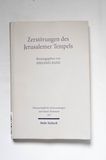
The Development of Greek and the New Testament
Netto: 57,75 €61,79€
inkl. MwSt. zzgl. Versand
Bearbeitungszeit: 3 Werktage
Sofort lieferbar (auf Lager)
1x Stück verfügbar
Buchzusammenfassung:
The introduction of the Erasmian pronunciation in 1528 had two dire consequences: Greek was divided into ancient and modern - a division that led to the neglect of the later periods of the language, and the pronunciation applied made impossible the detection of many communicatory aspects and obscured many text-critical problems. The author argues for the unity of the Greek language from Mycenaean times to the present. The New Testament appears during the time of transition (335 B.C. - A.D. 565) from ancient to Modern Greek. Morphological and syntactical analysis shows that at many important points the New Testament can be elucidated by later Greek, up to Neohellenic. Contents include: Introduction, The unity and evolution of the Greek language, The relevance of later Greek for the Exegesis of the New Testament, The transition from Attic to Neohellenic in Morphology and the New Testament, Syntactical Developments, The significance of the developments for the exegesis of the New Testament, The historical Greek pronunciation and the dichotomy of the language, The acoustic dimension in communication, The impact of the historical Greek pronunciation on the transmission of the New Testament text, Summary and Conclusions.
FAQ zum Buch
Der Gebrauch des Plurals kann in der Auslegung des Neuen Testaments dazu führen, dass eine Formulierung als Befehl oder Verbot interpretiert wird, anstatt als Aussage. Beispielsweise wird in bestimmten Passagen der Plural als eingebetteter Befehl wahrgenommen, der die Handlung direkt anweist. Zudem kann der Plural zeitliche Kontexte ausdrücken, wie in Konstruktionen, die “die Zeit ist gekommen“ bedeuten. Dies verdeutlicht, dass der Plural die semantische Funktion der Satzstruktur verändert. Dieses FAQ wurde mit KI erstellt, basierend auf der Quelle: S. 240, ISBN 9783161482908












